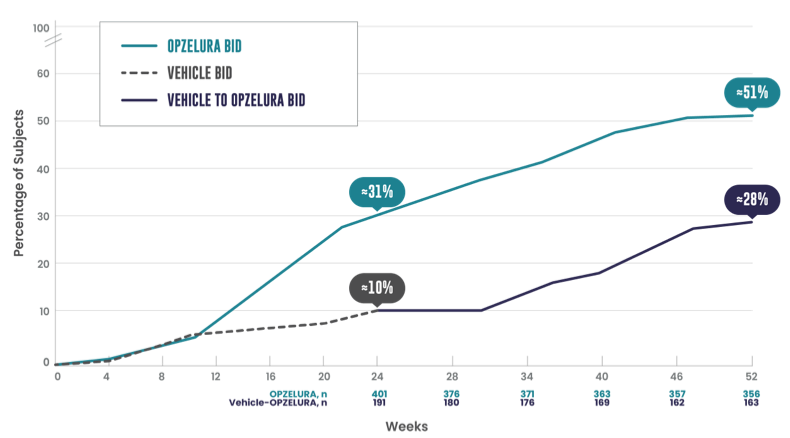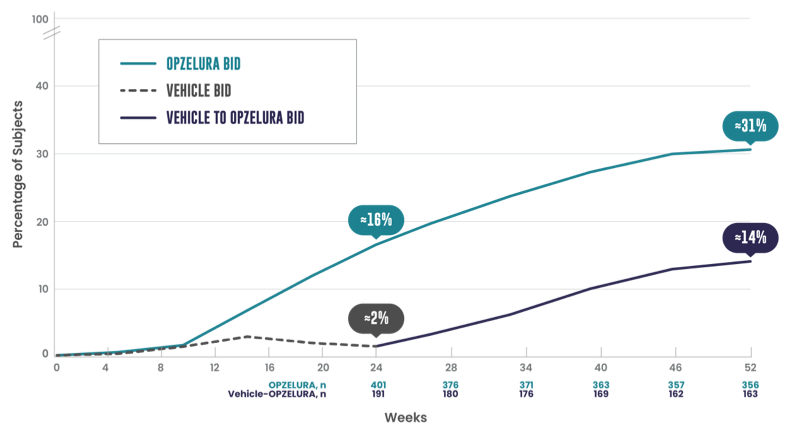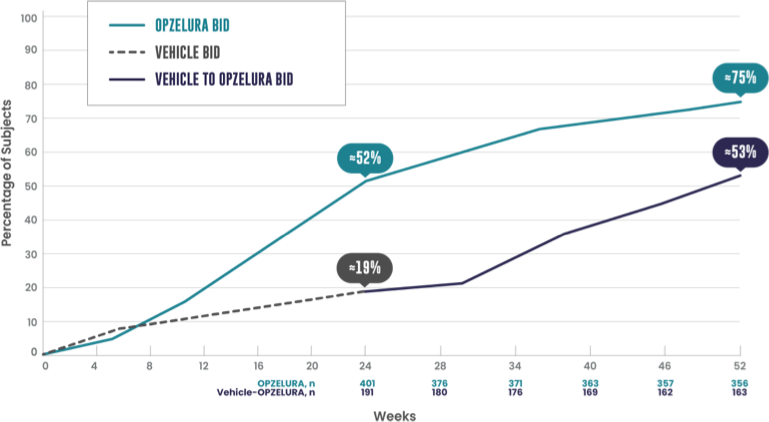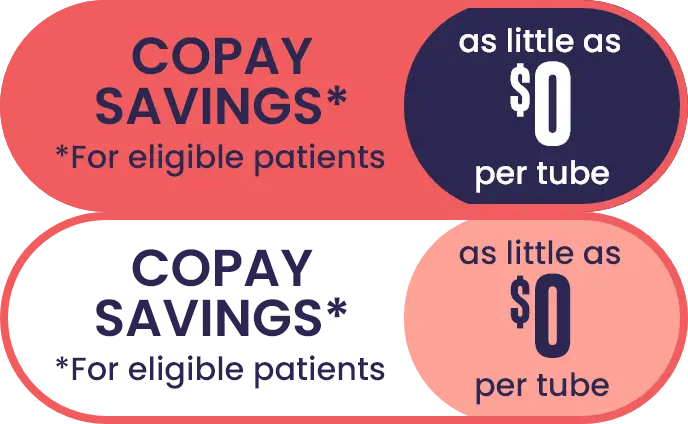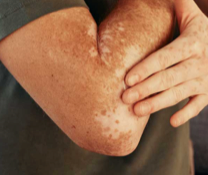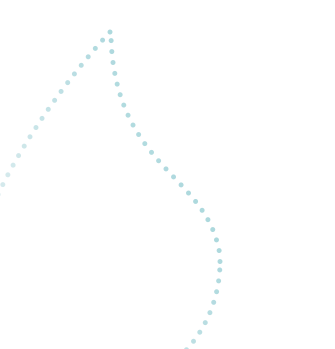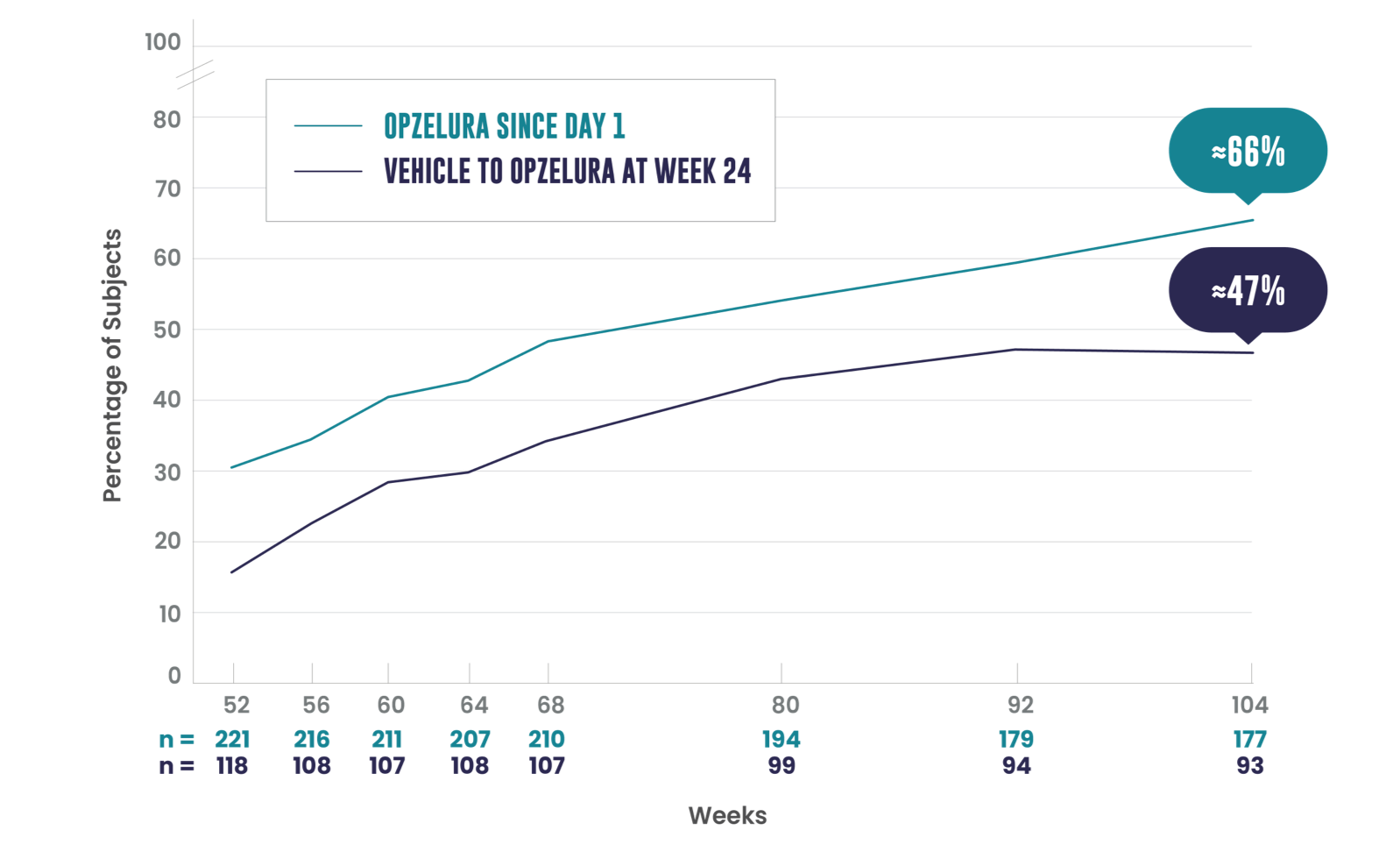(DESCRIPTION) Two microphones sit on a table as upbeat music enters.
(TITLE SLIDE) Opzelura® (ruxolitinib) cream 1.5% ON AIR
(ON-SCREEN TEXT)
INDICATION
OPZELURA is indicated for the topical treatment of nonsegmental vitiligo in adult and pediatric patients 12 years of age and older.
Limitations of Use: Use of OPZELURA in combination with therapeutic biologics, other JAK inhibitors, or potent immunosuppressants such as azathioprine or cyclosporine is not recommended.
IMPORTANT SAFETY INFORMATION
Serious infections leading to hospitalization or death, including tuberculosis and bacterial, invasive fungal, viral, and other opportunistic infections, have occurred in patients receiving Janus kinase inhibitors for inflammatory conditions. Regularly monitor patients for infection and manage it promptly.
Higher rate of all-cause mortality, including sudden cardiovascular death has been observed in patients treated with Janus kinase inhibitors for inflammatory conditions.
Lymphoma and other malignancies have been observed in patients treated with Janus kinase inhibitors for inflammatory conditions. Basal cell and squamous cell carcinoma have occurred. Perform periodic skin examinations during treatment and following treatment as appropriate.
Higher rate of MACE (including cardiovascular dealth, myocardial infarction, and stroke) has been observed in patients treated with Janus kinase inhibitors for inflammatory conditions.
Thrombosis, including deep venous thrombosis, pulmonary embolism, and arterial thrombosis, some fatal, have occurred in patients treated with Janus kinase inhibitors for inflammatory conditions.
Important Safety Information will be discussed in more detail, later in the video.
(DESCRIPTION) Sam K. and Sam N. sit at the table with the microphones and begin talking to each other.
(SPEECH) SAM NICOLINI: So did you track your progress in any way, like taking pictures or--
SAM K: Yeah, I probably took pictures almost daily in the beginning. [LAUGHTER]
Sam K: Hi, I'm Sam, and I have nonsegmental vitiligo, and I'm using OPZELURA.
SAM NICOLINI: Hi, I'm Sam, and I'm a dermatology physician assistant, and I treat nonsegmental vitiligo with OPZELURA.
(ON-SCREEN TEXT) SAM ACTUAL PATIENT TREATED WITH OPZELURA Not a clinical trial participant.
SAM NICOLINI CERTIFIED DERMATOLOGY PHYSICIAN ASSISTANT (PA)
(DISCLAIMER) For the topical treatment of nonsegmental vitiligo in adult and pediatric patients 12 years of age and older.1 This video is sponsored by Incyte. Sam and Sam were compensated for their time.
(SPEECH) SAM K: But she's not my healthcare provider.
SAM NICOLINI: We're best friends.
SAM K: And this is our OPZELURA Moment - On Air.
(TITLE SLIDE) ON AIR MY MOMENT WITH SAM & SAM
(DESCRIPTION) Sam K. shares her baseline photos with us, where most of her face and neck is depigmented from her vitiligo.
(SPEECH) SAM K: This is probably week one when I first started.
SAM N: Oh my gosh.
SAM K: You can see like my whole face is kind of covered, and down my neck.
SAM N: Yeah.
(ON-SCREEN TEXT) BEFORE TREATMENT2
(DISCLAIMER) OPZELURA was studied as a monotherapy for 24 weeks in 2 identical, phase 3 randomized studies, where 29.9% of those using OPZELURA saw 75% facial vitiligo repigmentation compared to 7.5% and 12.9% of those using vehicle.1
(DESCRIPTION) Sam K. shares her photos at 2 months, where we see the beginning of perifollicular repigmentation.
(SPEECH) SAM K: And then you can see kind of...
SAM N: Yeah, you clearly see, yeah.
Sam K: like the pigment filling in around my eyes...
(DESCRIPTION) Sam K. shares her photos at 8 months, where we see her cheeks and chin have notably more pigment.
(SPEECH) SAM N: Down your cheek area.
SAM K: ...and on my chin.
(DESCRIPTION) Sam K. shares her photos at 10 months, where we see her cheeks and forehead have notably more pigment.
(SPEECH) SAM K: And then most of my cheeks had already come back...
(DESCRIPTION) Sam K. shares her photos at 12 months, where most of her cheeks and forehead have more pigment.
(SPEECH) SAM N: Yeah.
SAM K: ...and my neck started filling in a little bit more. You can see like that whole side.
SAM N: Yep.
(DESCRIPTION) Sam K. shows us pictures from baseline and after one year of treatment, where she has significantly more pigment on her cheeks, forehead, and chin.
(SPEECH) SAM K: Again, like I didn't think there would ever [CHUCKLES] be a treatment that worked for me.
SAM N: Yeah.
[UPBEAT MUSIC] Hey!
(ON-SCREEN TEXT) FRIENDLY TIP: capture progress photos like Sam’s with consistent lighting, angles, and background. Learn what could be possible with OPZELURA at OPZELURAHCP.COM
(DISCLAIMER) OPZELURA is for topical use only. OPZELURA is not for ophthalmic, oral, or intravaginal use.1 Satisfactory patient response may require treatment with OPZELURA for more than 24 weeks. 51% of patients out of 356 who continued using OPZELURA in a less robust extension achieved 75% facial repigmentation at 52 weeks.1,2
(SPEECH) NARRATOR: Indication. OPZELURA is indicated for the topical treatment of nonsegmental vitiligo in adult and pediatric patients 12 years of age and older.
Limitations of use. Use of OPZELURA in combination with therapeutic biologics, other JAK inhibitors, or potent immunosuppressants such as azathioprine or cyclosporine is not recommended.
Important safety information. Serious infections. Patients treated with oral Janus kinase (JAK) inhibitors for inflammatory conditions are at risk for developing serious infections that may lead to hospitalization or death. Reported infections include: Active tuberculosis, which may present with pulmonary or extrapulmonary disease. Invasive fungal infections, including cryptococcosis and pneumocystosis. Bacterial, viral, including herpes zoster, and other infections due to opportunistic pathogens.
Avoid use of OPZELURA in patients with an active, serious infection, including localized infections. If a serious infection develops, interrupt OPZELURA until the infection is controlled. Carefully consider the benefits and risks of treatment prior to initiating OPZELURA in patients with chronic or recurrent infection. Closely monitor patients for the development of signs and symptoms of infection during and after treatment with OPZELURA.
Serious lower respiratory tract infections were reported in the clinical development program with topical ruxolitinib.
No cases of active tuberculosis (TB) were reported in clinical trials with OPZELURA. Cases of active TB were reported in clinical trials of oral JAK inhibitors used to treat inflammatory conditions. Consider evaluating patients for latent and active TB infection prior to administration of OPZELURA. During OPZELURA use, monitor patients for the development of signs and symptoms of TB.
Viral reactivation, including cases of herpes virus reactivation (e.g., herpes zoster), were reported in clinical trials with JAK inhibitors used to treat inflammatory conditions including OPZELURA. If a patient develops herpes zoster, consider interrupting OPZELURA treatment until the episode resolves.
Hepatitis B viral load (HBV-DNA titer) increases, with or without associated elevations in alanine aminotransferase and aspartate aminotransferase, have been reported in patients with chronic HBV infections taking oral ruxolitinib. OPZELURA initiation is not recommended in patients with active hepatitis B or hepatitis C.
MORTALITY. In a large, randomized, postmarketing safety study in rheumatoid arthritis (RA) patients 50 years of age and older with at least one cardiovascular risk factor comparing an oral JAK inhibitor to tumor necrosis factor (TNF) blocker treatment, a higher rate of all-cause mortality, including sudden cardiovascular death, was observed with the JAK inhibitor. Consider the benefits and risks for the individual patient prior to initiating or continuing therapy with OPZELURA.
MALIGNANCIES. Malignancies were reported in patients treated with OPZELURA. Lymphoma and other malignancies have been observed in patients receiving JAK inhibitors used to treat inflammatory conditions. In RA patients treated with an oral JAK inhibitor, a higher rate of malignancies (excluding non-melanoma skin cancer (NMSC)) was observed when compared with TNF blockers. Patients who are current or past smokers are at additional increased risk.
Consider the benefits and risks for the individual patient prior to initiating or continuing therapy with OPZELURA, particularly in patients with a known malignancy (other than successfully treated non-melanoma skin cancers), patients who develop a malignancy when on treatment, and patients who are current or past smokers.
Non-melanoma skin cancers, including basal cell and squamous cell carcinoma, have occurred in patients treated with OPZELURA. Perform periodic skin examinations during OPZELURA treatment and following treatment as appropriate. Exposure to sunlight and UV light should be limited by wearing protective clothing and using broad-spectrum sunscreen.
MAJOR ADVERSE CARDIOVASCULAR EVENTS (MACE). In RA patients 50 years of age and older with at least one cardiovascular risk factor treated with an oral JAK inhibitor, a higher rate of major adverse cardiovascular events (MACE) (defined as cardiovascular death, myocardial infarction, and stroke), was observed when compared with TNF blockers. Patients who are current or past smokers are at additional increased risk. Discontinue OPZELURA in patients who have experienced a myocardial infarction or stroke.
Consider the benefits and risks for the individual patient prior to initiating or continuing therapy with OPZELURA, particularly in patients who are current or past smokers and patients with other cardiovascular risk factors. Patients should be informed about the symptoms of serious cardiovascular events and the steps to take if they occur. Discontinue OPZELURA in patients that have experienced a myocardial infarction or stroke.
THROMBOSIS. Thromboembolic events were observed in trials with OPZELURA. Thrombosis, including pulmonary embolism (PE), deep venous thrombosis (DVT), and arterial thrombosis have been reported in patients receiving JAK inhibitors used to treat inflammatory conditions. Many of these adverse reactions were serious and some resulted in death. In RA patients 50 years of age and older with at least one cardiovascular risk factor treated with an oral JAK inhibitor, a higher rate of thrombosis was observed when compared with TNF blockers. Avoid OPZELURA in patients at risk. If symptoms of thrombosis occur, discontinue OPZELURA and treat appropriately.
CYTOPENIAS. Thrombocytopenia, anemia, neutropenia, lymphopenia, and leukopenia were reported in the clinical trials with OPZELURA. Consider the benefits and risks for individual patients who have a known history of these events prior to initiating therapy with OPZELURA. Perform CBC monitoring as clinically indicated. Discontinue OPZELURA if signs and/or symptoms associated with clinically significant decreases in laboratory values occur.
Lipid Elevations. Treatment with oral ruxolitinib has been associated with increases in lipid parameters including total cholesterol, low-density lipoprotein (LDL) cholesterol, and triglycerides.
Adverse Reactions. The most common adverse reactions (≥1%) are application site acne, application site pruritus, nasopharyngitis, headache, urinary tract infection, application site erythema, and pyrexia.
Pregnancy Registry. There is a pregnancy registry that monitors pregnancy outcomes in pregnant persons exposed to OPZELURA during pregnancy. Pregnant persons exposed to OPZELURA and healthcare providers should report OPZELURA exposure by calling 1-855-463-3463 or visiting www.opzelura.pregnancy.incyte.com.
Lactation. Advise women not to breastfeed during treatment with OPZELURA and for approximately four weeks after the last dose (approximately 5-6 elimination half-lives).
Please see Full Prescribing Information, including Boxed Warning, and Medication Guide for OPZELURA.

